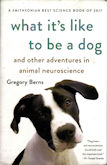In What It’s Like to Be a Dog, Berns takes us into the minds of wild animals: sea lions who can learn to dance, dolphins who can see with sound, and even the now-extinct Tasmanian tiger. Berns’s latest scientific breakthroughs prove definitively that animals have feelings very much like we do—a revelation that forces us to reconsider how we think about and treat animals.
Written with insight, empathy, and humor, What It’s Like to Be a Dog is the twenty-first century’s manifesto for animal liberation.
Berns and his team have scanned the brains of dogs trained to stay still inside MRI scanners while they perform certain cognitive tasks. From this, he can see what is happening inside their heads as they think, react, and act. The findings are very analogous to processes in human brains.
He also recounts other experiments on a range of (this time dead) animals, scanning the structure of their brains. From sick sea lions to extinct thylacines (Tasmanian Tigers), he scans and discovers analogous structures across multiple species.
Each individual story is engaging, but the overall collection feels a bit disjointed. In particular there is a strange piece about the death of the last captive Tasmanian Tiger that seems out of place, and doesn’t really go anywhere.
However, from all these experiments, Berns concludes, convincingly, that animals feel in ways analogous (but not identical) to the way people feel. This has profound consequences for animal ethics and welfare.
